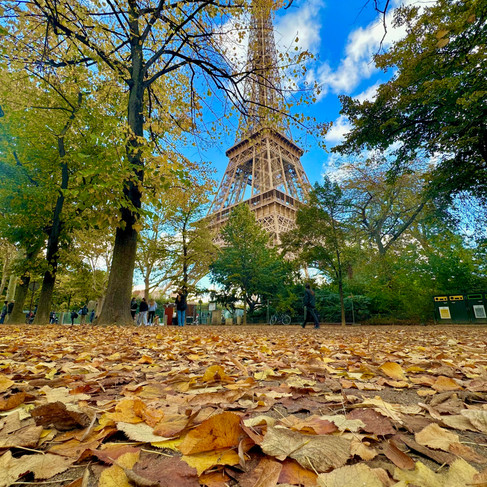A Morning Parisian Walk in Autumn
- Kim Adellton
- Feb 26
- 5 min read
Oh, the City of Lights... Who wouldn't dream of walking around Paris and looking at the majestic Eiffel Tower? Last Autumn, I had a 24-hour layover in this romantic and historic city and decided to have a morning walk. Here's how it went.

At A Glance
Paris, France

A city like no other, Paris is a unique blend of beauty, romance, and history. Imagine a place where ancient architecture meets modern style. Grand boulevards stretch out like arteries throughout the city, and the Seine River flows gently through the heart of it all.
Not only does it house some of the world's most iconic and historic structures, it also hosts world-class museums and galleries. And then there's the food – oh, the food! From croissants and baguettes to escargots and duck confit - Paris is a culinary paradise.
With its rich history and complex past, every step enchants me as I go through the remnants of a city shaped by centuries of politics, culture, and creativity.
Let me take you on my recent autumn morning walk in this opulent city...
An Autumn Morning Walk in Paris
20:33 local time, we touched down in Paris. Since I had a quick bite before landing, I crashed into my hotel bed after a quick shower. Energized, I got up early the next day and had a morning walk in the city. Paris is definitely a sight during autumn and I simply could not miss it.
Since we were staying at an airport hotel near Charles de Gaulle Airport, I had to take a 45-minute train ride to the city. For 22.60 euros, I chose to purchase the one-day ticket pass. It included my fair to and from the city and unlimited access within Paris.
My goal is to reach the Eiffel Tower before lunchtime... let's see.
Arc de Triomphe
Alighting at the Charles de Gaulle Etoile Station, I followed the signs leading to the Arc de Triomphe. Seeing the majestic view of the arc from the escalator, I remembered the first time I saw it 8 years ago. The magic is still there!

Commissioned by Napoleon in 1806, this monument was built to honor the soldiers who fought and died for France during the French Revolutionary and Napoleonic Wars. This iconic landmark stands 50 meters tall and is definitely a must-see in Paris.
Champs-Élysées
I continued my Parisian walk along the picturesque sidewalks of the famous Avenue de Champs-Élysées. This avenue is lined with high-end boutiques and the New Louis Vitton building got my attention with its suitcase facade. It was right beside the flagship store (constructed in the 19th Century). I wasn't able to take photos of the new store though... But it was included in my walking video. See the video here.

The avenue also has some art galleries and restaurants. This is the perfect place to have a glimpse of the upscaled and elegant Parisian life.
Continuing, I came across the 6 fountains in a roundabout named Les Fontaines du Rond-point des Champs-Élysées. Walking straight, I passed by the Theatre du Rond-point, then the Square de Berlin and its charming autumn colors.
Square de Berlin
Why is there a Berlin Square in Paris? This was named in 1957, over a decade after World War II, as a gesture of reconciliation between France and Germany. It symbolizes the Franco-German friendship. It covers an area of about 5,460 square meters.
Grand Palais and Petit Palais
Arriving at Place Clemenceau, a small square at the intersection of Champs-Élysées and Avenue Winston Churchill, you'll get a clear view of both the Grand and the Petit Palais.
The Grand Palais is a glass-roofed building that houses an Opera House, the Paris Sewer Museum (Musée des Égouts de Paris), and exhibition spaces. Also known as Palais Garnier, named after its designer - Charles Garnier, it was built between 1861 and 1875.

The Petit Palais is a museum showcasing a collection of French art and artifacts from the 19th and 20th centuries and hosts temporary exhibitions throughout the year. It was originally built in 1900 as a temporary building for the 1900 World's Fair - the Exposition Universelle. The design of this building is so intricate and the size of this thing is far from petit.

Pont Alexander III Bridge
Continuing my walk along Av. Winston Churchill, I reached the Pont Alexander III Bridge over the River Seine. This bridge was opened in 1905 and is considered one of the greatest bridges of the 20th century. The view of Eiffel Tower from this bridge is stunning! You can also have a glimpse of Pont des Invalides.

Seine River
The Seine River is a major river in France, stretching approximately 777 kilometers (483 miles) from its source in the Auvergne region to the English Channel. It flows through the heart of Paris and plays a crucial role in the city's history and development. Pronounced 'Sehn' in French, it served as the primary water source, and a major transportation route for trade, commerce, and tourism.

Pont des Invalides
Pont des Invalides is a bridge, a popular landmark and tourist destination in Paris. Recognized as a UNESCO World Heritage Site since 1991, it is known for its elegant and imposing design. It was built in 1672. It is located near the Hotel des Invalides which houses the famous Église du Dôme, the Panthéon, and the Musée de l'Armée. The complex is also home to the tomb of Napoleon Bonaparte and many other famous French military leaders.

Rue Cler
I continued walking towards the Eiffel Tower and stumbled upon a pedestrian street called Rue Cler lined with quaint restaurants, patisseries, boutiques, and cafes. During the 19th and 20th centuries, this street was known for its upscale department stores that cater to the needs of local aristocrats and upper-class Parisians. Nowadays, it is still a popular shopping destination and tourist spot due to its picturesque atmosphere and historic landmarks.
I turned to Av. de la Molte-Picquet and came across École-Militaire or the Official Military Academy of the French Army. Right across the street is the Grand Palais Ephemere and eventually the Eiffel Tower.
Eiffel Tower
The Eiffel Tower is undeniably the most iconic landmark of Paris. Standing at an impressive 324 meters (1,063 ft), it was considered the tallest man-made structure upon its completion in March 1889. It was made of heated and hammered hot iron meticulously riveted together to form the iron lattice structure of the tower. Of course, there's much more intricacy and structural terms to describe it accurately... As for a mere human like myself, it is just... MAJESTIC.
After taking these pictures, I hurriedly returned to my hotel room. I had a quick bite, took a nap, and then, it was time to work.
How to go around Paris
Having been to Paris a couple of times, here are some of my tips in getting around the city.
Use Public Transport – The Paris Métro is fast and affordable
Get a Paris Metro Pass for multiple trips - You may use Navigo or Visite Pass.
Walk When Possible – Many landmarks are close to each other, and walking lets you soak in the beauty of Paris.
Avoid Taxis – They’re expensive. Use Uber or public transport instead.
And just a word of caution, this applies anywhere... Always be vigilant and keep an eye on your belongings.
Here's a video of my autumn morning walk in this lovely city.
Have a fun and safe Paris Trip!








Comments